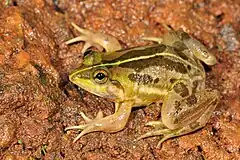| Euphlyctis[1] | |||
| Fitzinger, 1843[2] | |||
 Przedstawiciel rodzaju – E. aloysii | |||
| Systematyka | |||
| Domena | |||
|---|---|---|---|
| Królestwo | |||
| Typ | |||
| Podtyp | |||
| Gromada | |||
| Rząd | |||
| Rodzina | |||
| Podrodzina | |||
| Rodzaj |
Euphlyctis | ||
| Typ nomenklatoryczny | |||
|
Rana leschenaultii A.M.C. Duméril & Bibron, 1841 (= Rana cyanophlyctis Schneider, 1799) | |||
| Synonimy | |||
|
| |||
| Gatunki | |||
| |||
Euphlyctis – rodzaj płazów bezogonowych z podrodziny Dicroglossinae w rodzinie Dicroglossidae.
Zasięg występowania
Rodzaj obejmuje gatunki występujące na południowo-zachodnim Półwyspie Arabskim; od Pakistanu i Indii do Afganistanu, Nepalu, przez Mjanmę do Tajlandii i w Sri Lance[4].
Systematyka
Etymologia
- Euphlyctis: gr. ευ eu „dobry, prawdziwy, ładny”[5]; φλυκτις phluktis, φλυκτιδος phluktidos „czyrak, wrzód”[6].
- Phrynoderma: gr. φρυνη phrunē, φρυνης phrunēs „ropucha”[7]; δερμα derma, δερματος dermatos „skóra”[8]. Gatunek typowy: Rana cutipora A.M.C. Duméril & Bibron, 1841 (= Rana hexadactyla Lesson, 1834).
- Dicroglossus: gr. δικρoος dikroοs „rozszczepiony, rozwidlony”[9]; γλωσσα glōssa „język”[10]. Gatunek typowy: Dicroglossus adolfi Günther, 1860 (= Rana cyanophlyetis Schneider, 1799).
Podział systematyczny
Do rodzaju należą następujące gatunki[4]:
- Euphlyctis adolfi (Gunther, 1860)
- Euphlyctis aloysii Joshy, Alam, Kurabayashi, Sumida & Kuramoto, 2009
- Euphlyctis cyanophlyctis (Schneider, 1799) – żaba kumakowata[11]
- Euphlyctis ehrenbergii (Peters, 1863)
- Euphlyctis hexadactyla (Lesson, 1834)
- Euphlyctis jaladhara Dinesh, Channakeshavamurthy, Deepak, Shabnam, Ghosh & Deuti, 2022
- Euphlyctis karaavali Priti, Naik, Seshadri, Singal, Vidisha, Ravikanth & Gururaja, 2016
- Euphlyctis kerala Dinesh, Channakeshavamurthy, Deepak, Ghosh & Deuti, 2021
Przypisy
- ↑ Euphlyctis, [w:] Integrated Taxonomic Information System (ang.).
- 1 2 L.J.F.J. Fitzinger: Systema reptilium. Fasciculus primus, Amblyglossae. Vindobonae: Braumüller et Seidel, 1843, s. 31. (łac.).
- ↑ A.Ch.L.G. Günther. Contribution to the knowledge of the reptiles of the Himalaya mountains. „Proceedings of the Zoological Society of London”. 28, s. 158, 1860. (ang.).
- 1 2 Darrel R. Frost: Euphlyctis Fitzinger, 1843. [w:] Amphibian Species of the World 6.2, an Online Reference [on-line]. American Museum of Natural History. [dostęp 2023-12-08]. (ang.).
- ↑ Jaeger 1944 ↓, s. 86.
- ↑ Jaeger 1944 ↓, s. 171.
- ↑ Jaeger 1944 ↓, s. 173.
- ↑ Jaeger 1944 ↓, s. 70.
- ↑ Jaeger 1944 ↓, s. 71.
- ↑ Jaeger 1944 ↓, s. 97.
- ↑ E. Keller (red.), J.H. Reinchholf, G. Steinbach, G. Diesener, U. Gruber, K. Janke, B. Kremer, B. Markl, J. Markl, A. Shlüter, A. Sigl & R. Witt: Gady i płazy. Warszawa: Świat Książki, 2003, s. 68, seria: Leksykon Zwierząt. ISBN 83-7311-873-X. (pol.).
Bibliografia
- Edmund C. Jaeger, Source-book of biological names and terms, wyd. 1, Springfield: Charles C. Thomas, 1944, s. 1–256, OCLC 637083062 (ang.).
This article is issued from Wikipedia. The text is licensed under Creative Commons - Attribution - Sharealike. Additional terms may apply for the media files.